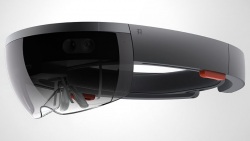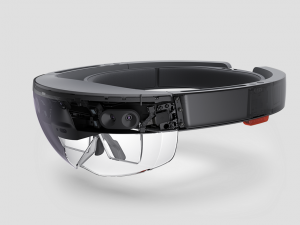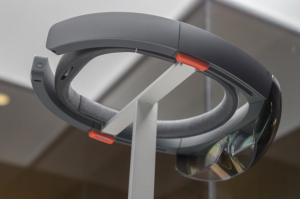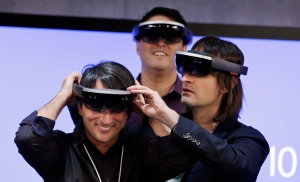Difference between revisions of "Microsoft HoloLens"
(→Main characteristics: added battery life info) |
(added link for later) |
||
| (One intermediate revision by the same user not shown) | |||
| Line 75: | Line 75: | ||
HoloLens is a self-contained computer that does not need additional connection to other devices. It offers augmented reality in the form of so called “holograms”<ref name="ref1"/>, which are virtual elements embedded into what the user sees through the HoloLens. These holograms are pinned or anchored to real, physical elements in the environment. It also features binaural stereo speakers for providing positional audio. The control is achieved through a built-in sensor array that serves as a natural user interface that can be interacted with with gaze, voice and especially hand gestures.<ref>FITZSIMMONS, Michelle. Hands on: Microsoft HoloLens review. TechRadar [online]. 2015, Jun 19. Available online at: http://www.techradar.com/reviews/wearables/microsoft-hololens-1281834/review (Retrieved Jul 28, 2015)</ref> | HoloLens is a self-contained computer that does not need additional connection to other devices. It offers augmented reality in the form of so called “holograms”<ref name="ref1"/>, which are virtual elements embedded into what the user sees through the HoloLens. These holograms are pinned or anchored to real, physical elements in the environment. It also features binaural stereo speakers for providing positional audio. The control is achieved through a built-in sensor array that serves as a natural user interface that can be interacted with with gaze, voice and especially hand gestures.<ref>FITZSIMMONS, Michelle. Hands on: Microsoft HoloLens review. TechRadar [online]. 2015, Jun 19. Available online at: http://www.techradar.com/reviews/wearables/microsoft-hololens-1281834/review (Retrieved Jul 28, 2015)</ref> | ||
| − | The display projection does not occupy the entire user’s view but only a small portion, similar to the functioning of other devices of the same category. Nate Ralph, associated editor of CNET, describes the created image as “a holographic field that feels like looking at a 20-inch screen from a few feet away.”<ref>RALPH, Nate. Building holograms with Microsoft HoloLens (hands-on). CNET [online]. 2015, Apr 30. Available online at: http://www.cnet.com/products/microsoft-hololens/ (Retrieved Jul 28, 2015)</ref> | + | The display projection does not occupy the entire user’s view but only a small portion, similar to the functioning of other devices of the same category. Nate Ralph, associated editor of CNET, describes the created image as “a holographic field that feels like looking at a 20-inch screen from a few feet away.”<ref>RALPH, Nate. Building holograms with Microsoft HoloLens (hands-on). CNET [online]. 2015, Apr 30. Available online at: http://www.cnet.com/products/microsoft-hololens/ (Retrieved Jul 28, 2015)</ref> Microsoft stated that the image is equal to "looking at a 15-inch monitor that's around two feet from your view"<ref name="vergebatterlifeaviv" /> currently (as of January 2016). |
HoloLens is strapped to the user’s head and can be further adjusted to better accommodate to the user’s needs. The controls are located above the ears at the top of the device’s frame.<ref name="ref2">Microsoft HoloLens Hardware. Microsoft Corp. [online] Available online at: https://www.microsoft.com/microsoft-hololens/en-us/hardware (Retrieved Jul 28, 2015)</ref> | HoloLens is strapped to the user’s head and can be further adjusted to better accommodate to the user’s needs. The controls are located above the ears at the top of the device’s frame.<ref name="ref2">Microsoft HoloLens Hardware. Microsoft Corp. [online] Available online at: https://www.microsoft.com/microsoft-hololens/en-us/hardware (Retrieved Jul 28, 2015)</ref> | ||
| + | |||
| + | http://www.pcworld.com/article/3039822/consumer-electronics/we-found-7-critical-hololens-details-that-microsoft-hid-inside-its-developer-docs.html | ||
[[File:MicrosoftHoloLens_2.png|thumb|right|alt=Closer look at the inner workings of HoloLens|Closer look at the inner workings of HoloLens.]] | [[File:MicrosoftHoloLens_2.png|thumb|right|alt=Closer look at the inner workings of HoloLens|Closer look at the inner workings of HoloLens.]] | ||
| Line 86: | Line 88: | ||
It is speculated that the main sensor is an advanced version of the Kinect 2.0 camera and that HoloLens might contain several Intel technologies, mainly its Intel Atom Cherry Trail chipset with Intel RealSense gesture control system. The headset is also equipped with four HD and depth cameras as well as an infra-red sensor.<ref>http://www.alphr.com/microsoft/microsoft-hololens</ref> | It is speculated that the main sensor is an advanced version of the Kinect 2.0 camera and that HoloLens might contain several Intel technologies, mainly its Intel Atom Cherry Trail chipset with Intel RealSense gesture control system. The headset is also equipped with four HD and depth cameras as well as an infra-red sensor.<ref>http://www.alphr.com/microsoft/microsoft-hololens</ref> | ||
| − | At an event in Tel Aviv, Microsoft's Technical Evangelist Bruce Harris informed that the device will have a battery life spanning from 2.5 to 5.5 hours on average.<ref>http://www.theverge.com/2016/1/16/10778864/microsoft-hololens-battery-life-features</ref><ref>https://www.youtube.com/watch?v=vXu5toPPqVE</ref> | + | At an event in Tel Aviv, Microsoft's Technical Evangelist Bruce Harris informed that the device will have a battery life spanning from 2.5 to 5.5 hours on average.<ref name="vergebatterlifeaviv">http://www.theverge.com/2016/1/16/10778864/microsoft-hololens-battery-life-features</ref><ref>https://www.youtube.com/watch?v=vXu5toPPqVE</ref> |
=== Purpose === | === Purpose === | ||
Latest revision as of 13:20, 3 March 2016
| Microsoft HoloLens | |
|---|---|

|
|
| Category | smartglasses |
| Developer | Microsoft Corporation |
| Announced | January 2015[1] |
| Released | Developers: 2016[2]
Consumers: |
| Price | 3000 USD[3][2] |
| Operating system | Windows |
| Display | unknown |
| Resolution | pixels |
| Weight | g |
| Controls | gestural, voice, gaze, inertial |
| Standalone[4] | |
| http://www.microsoft.com/microsoft-hololens/en-us | |
Microsoft HoloLens is the first device built for the Microsoft Holographic platform for augmented reality running on the Windows 10 operating system. The Holographic platform is planned to work together with desktop-running Windows 10 and other Microsoft products, such as XBOX or smartphones, through common API.[5]
HoloLens is a self-contained computer that does not need additional connection to other devices. It offers augmented reality in the form of so called “holograms”[5], which are virtual elements embedded into what the user sees through the HoloLens. These holograms are pinned or anchored to real, physical elements in the environment. It also features binaural stereo speakers for providing positional audio. The control is achieved through a built-in sensor array that serves as a natural user interface that can be interacted with with gaze, voice and especially hand gestures.[6]
The display projection does not occupy the entire user’s view but only a small portion, similar to the functioning of other devices of the same category. Nate Ralph, associated editor of CNET, describes the created image as “a holographic field that feels like looking at a 20-inch screen from a few feet away.”[7] Microsoft stated that the image is equal to "looking at a 15-inch monitor that's around two feet from your view"[8] currently (as of January 2016).
HoloLens is strapped to the user’s head and can be further adjusted to better accommodate to the user’s needs. The controls are located above the ears at the top of the device’s frame.[9]
Contents
Main characteristics
HoloLens features depth camera with a 120x120 degrees FOV, microphone array, stereo speakers capable of binaural audio, an accelerometer, gyroscope and a magnetometer. It also features so called Holographic Processing Unit which is Microsoft’s custom build coprocessor that processes and combines data from all sensors. [9][10] Not much more is officially known about the further specifications of the device. Microsoft does not want to share any details concerning hardware yet. Microsoft forbade anyone to bring any electronic devices to the demo area and so the available information is limited to reviews and guesses.[11][12][13] The device will be released to the developers participating in the Windows Insider program in the US and Canada in the beginning of the year 2016. The price of the developer version is set to 3000 USD.[14]
It is speculated that the main sensor is an advanced version of the Kinect 2.0 camera and that HoloLens might contain several Intel technologies, mainly its Intel Atom Cherry Trail chipset with Intel RealSense gesture control system. The headset is also equipped with four HD and depth cameras as well as an infra-red sensor.[15]
At an event in Tel Aviv, Microsoft's Technical Evangelist Bruce Harris informed that the device will have a battery life spanning from 2.5 to 5.5 hours on average.[8][16]
Purpose
Microsoft’s official promotion text:
We envisioned a world where technology could become more personal—where it could adapt to the natural ways we communicate, learn, and create. Where our digital lives would seamlessly connect with real life. The result is the world’s most advanced holographic computing platform, enabled by Windows 10. For the first time ever, Microsoft HoloLens brings high-definition holograms to life in your world, where they integrate with your physical places, spaces, and things. Holograms will improve the way you do things every day, and enable you to do things you’ve never done before.[5]
Company & People
- Alex Kipman - Project HoloLens, Chief Inventor[17]
- Kudo Tsunoda - General manager at XBOX[18]
Important Dates
- In development since 2010.[19]
- Announced at Microsoft Windows 10 keynote in January 2015.[20]
- Will be available to developers in the beginning of 2016.[21]
Ethical Issues & Health Risks
There has been no issues noted with Microsoft HoloLens so far specifically. However, some general issues connected to Smartglasses in general still apply.
Enhancement/Therapy/Treatment
Enhancement - HoloLens is meant to be used for entertainment and industrial use (3D modelling, collaboration in real-time).
At this stage of the development, the device does not offer any treatment capabilities, although there might be some application running on the device that could offer such features.
Public & Media Impact and Presentation
Overall, HoloLens seems to be very well received by the media. Microsoft’s embargo on any detailed technical information leaves a lot for speculation, though. Media outlets wonder mainly about the resolution of the device’s display, as Microsoft never stated an exact resolution, for example.[22] However, the overall enthusiasm for the device is not shared uniformly.[23] According to The Register, HoloLens suffers the same drawbacks as many other similar devices. The projection area is very small and the user has to look directly at the holograms to actually see them.[24] Microsoft stated that while the hardware of the device will indeed improve before the final release, the field of view will change only marginally. In an interview for Verge, the General manager of XBOX Kudo Tsunoda said, that the device will not be capable of full peripheral field of view.[25]
Another common opinion found in the tech media is that with this device Microsoft hopes to renew its popularity as a tech visionary, finally offering new and ‘exciting’ technology.[17] The company will be taking HoloLens on a tour through the United States and Canada to showcase the technology to developers.[26]
Public Policy
There is no legislation concerning the device at the moment. However, some policies regarding Smartglasses may apply.
Related Technologies, Project or Scientific Research
- Microsoft Kinect
- Windows 10
References
- ↑ http://www.theverge.com/2015/1/21/7867593/microsoft-announces-windows-holographic
- ↑ 2.0 2.1 http://arstechnica.com/gadgets/2015/10/microsoft-hololens-development-edition-coming-q1-2016-for-3000/
- ↑ https://www.microsoft.com/microsoft-hololens/en-us/development-edition
- ↑ Shows if the device is a standalone wearable computer or if it needs to be connected to a processing unit to function.
- ↑ 5.0 5.1 5.2 Microsoft HoloLens. Microsoft Corp. [online] Available online at: https://www.microsoft.com/microsoft-hololens/en-us (Retrieved Jul 28, 2015)
- ↑ FITZSIMMONS, Michelle. Hands on: Microsoft HoloLens review. TechRadar [online]. 2015, Jun 19. Available online at: http://www.techradar.com/reviews/wearables/microsoft-hololens-1281834/review (Retrieved Jul 28, 2015)
- ↑ RALPH, Nate. Building holograms with Microsoft HoloLens (hands-on). CNET [online]. 2015, Apr 30. Available online at: http://www.cnet.com/products/microsoft-hololens/ (Retrieved Jul 28, 2015)
- ↑ 8.0 8.1 http://www.theverge.com/2016/1/16/10778864/microsoft-hololens-battery-life-features
- ↑ 9.0 9.1 Microsoft HoloLens Hardware. Microsoft Corp. [online] Available online at: https://www.microsoft.com/microsoft-hololens/en-us/hardware (Retrieved Jul 28, 2015)
- ↑ SHAH, Agam. Microsoft's HoloLens uses unreleased Intel Atom chip. PC World [online]. 2015, Jan 22. Available online at: http://www.pcworld.com/article/2874352/microsofts-hololens-uses-unreleased-intel-atom-chip.html (Retrieved Jul 28, 2015)
- ↑ Microsoft HoloLens. VRWiki - a Wiki about VR [online]. Available online at: https://vrwiki.wikispaces.com/Microsoft+HoloLens (Retrieved Jul 28, 2015)
- ↑ FREDZL,. Reddit: /r/oculus [online]. Available online at: https://www.reddit.com/r/oculus/comments/2t74sf/microsoft_announces_windows_holographic_ar/cnwsyny (Retrieved Jul 28, 2015)
- ↑ PHILLIPS, John. My HoloLens acid trip was fascinating, but left a funny taste in my mouth. PC World [online]. 2015, May 1. Available online at: http://www.pcworld.com/article/2917379/my-hololens-acid-trip-was-fascinating-but-left-a-funny-taste-in-my-mouth.html (Retrieved Jul 28, 2015)
- ↑ http://www.techradar.com/reviews/wearables/microsoft-hololens-1281834/review
- ↑ http://www.alphr.com/microsoft/microsoft-hololens
- ↑ https://www.youtube.com/watch?v=vXu5toPPqVE
- ↑ 17.0 17.1 HEMPEL, Jessi. Microsoft in the age of Satya Nadella. Wired [online]. 2015, Jan. Available online at: http://www.wired.com/2015/01/microsoft-nadella/ (Retrieved Jul 28, 2015)
- ↑ http://www.polygon.com/2015/3/9/8177117/xbox-kudo-tsunoda-microsoft
- ↑ HEMPEL, Jessi. Project HoloLens: Our Exclusive Hands-On With Microsoft’s Holographic Goggles. Wired [online]. 2015, Jan 21. Available online at: http://www.wired.com/2015/01/microsoft-hands-on (Retrieved Jul 28, 2015)
- ↑ TAVES, Max a Nick STATT. Microsoft HoloLens dazzles at Build conference, but availability still a mystery. CNET [online]. 2015, Apr 29. Available online at: http://www.cnet.com/news/microsoft-hololens-dazzles-at-build-conference-but-availability-still-a-mystery/ (Retrieved Jul 28, 2015)
- ↑ Microsoft HoloLens. Alphr [online]. 2015, Jul 13. Available online at: http://www.alphr.com/microsoft/microsoft-hololens (Retrieved Jul 28, 2015)
- ↑ SAVOV, Vlad. Microsoft announces Windows Holographic with HoloLens headset. The Verge [online]. 2015, Jan 21. Available online at: https://www.theverge.com/2015/1/21/7867593/microsoft-announces-windows-holographic (Retrieved Jul 28, 2015)
- ↑ MCCRACKEN, Harry. Microsoft HoloLens And The Danger Of Mismanaged Expectations. Fast Company [online]. 2015, May 1. Available online at: https://www.fastcompany.com/3045820/microsoft-hololens-and-the-danger-of-mismanaged-expectations (Retrieved Jul 28, 2015)
- ↑ MCALLISTER, Neil. Microsoft HoloLens or Hollow Lens? El Reg stares down cyber-specs' code. The Register [online]. 2015, May 1. Available online at: http://www.theregister.co.uk/2015/05/01/microsoft_hololens_feature/ (Retrieved Jul 28, 2015)
- ↑ http://www.theverge.com/2015/6/18/8809323/microsoft-hololens-field-of-view-kudo-tsunoda
- ↑ http://www.techtimes.com/articles/93747/20151010/microsoft-takes-hololens-on-tour-in-us-and-canada-to-showcase-augmented-reality-headset-to-developers.htm


